
Baird's sandpiper is a small shorebird. It is among those calidrids which were formerly included in the genus Erolia, which was subsumed into the genus Calidris in 1973. The genus name is from Ancient Greek kalidris or skalidris, a term used by Aristotle for some grey-coloured waterside birds. The English name and specific bairdii commemorate Spencer Fullerton Baird, 19th-century naturalist and assistant secretary of the Smithsonian Institution.

The collared trogon is a near passerine bird in family Trogonidae, the quetzals and trogons. It is found in Mexico, throughout Central America, and in northern South America.

The white-tailed trogon is a near passerine bird in the trogon family. It is found in tropical humid forests of the Chocó, ranging from Panama, through western Colombia, to western Ecuador. It was formerly considered a subspecies of T. viridis, which is widespread in South America east of the Andes, but under the English name white-tailed trogon.

The snowcap is a species of hummingbird in the "emeralds", tribe Trochilini of subfamily Trochilinae. It is found in Costa Rica, Honduras, Nicaragua, and Panama.
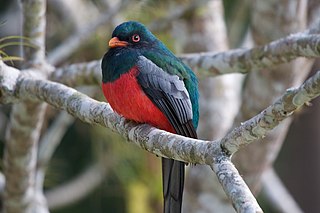
The slaty-tailed trogon is a near passerine bird in the family Trogonidae, the quetzals and trogons. It is found in Mexico, throughout Central America, and in Colombia and Ecuador.

The green thorntail is a small hummingbird in the "coquettes", tribe Lesbiini of subfamily Lesbiinae. It is found in Colombia, Costa Rica, Ecuador, and Panama.
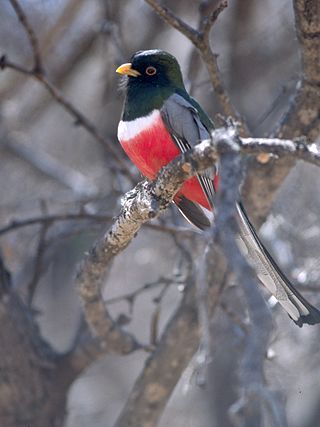
The elegant trogon, also known as the coppery-tailed trogon, is a near passerine bird in the trogon family.
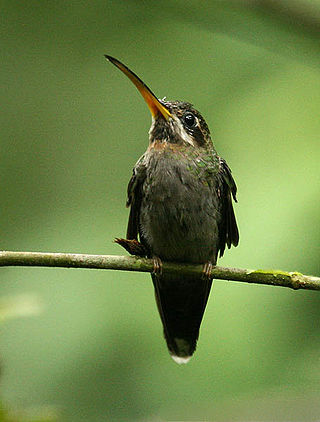
The band-tailed barbthroat is a medium-sized hummingbird that is found from southeastern Guatemala and Belize to western Ecuador and western Venezuela.

The green-crowned brilliant is species of hummingbird in the "brilliants", tribe Heliantheini in subfamily Lesbiinae. It is found in Colombia, Costa Rica, Ecuador, and Panama. It is also known as the green-fronted brilliant.

The black-capped pygmy tyrant is the smallest passerine bird in its range, though larger than its cousin, the short-tailed pygmy tyrant. This tyrant flycatcher occurs from Costa Rica to north-western Ecuador.

The Veraguan mango is a species of hummingbird in the family Trochilidae. It is found in Panama and recently in Costa Rica. It was considered conspecific with the Green-breasted Mango but was separated due to morphological and geographical differences in 1995.

The lovely cotinga is a species of bird in the family Cotingidae. It is found in North and Central America from southern Mexico through Guatemala, Belize, Honduras and Nicaragua to Costa Rica with reports from western Panama. Its natural habitats are tropical moist lowland forests and heavily degraded former forest. The male is a bright turquoise blue while the female is greyish-brown with pale underparts. Because of its total population size and wide range, this species is not yet considered vulnerable.

The silvery-throated jay is a species of bird in the family Corvidae. It is found in the Talamancan montane forests of Costa Rica and western Panama. The IUCN has rated its conservation status as being of "least concern".
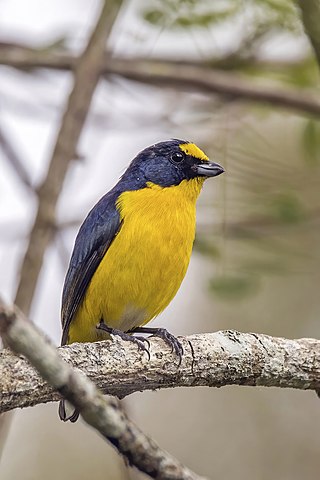
The yellow-throated euphonia is a species of songbird in the family Fringillidae. It is found in southeastern Mexico and throughout Central America with its range stretching from Belize south to western Panama. It inhabits primarily both humid and dry regions where it prefers the forest edge, open woodland, and shaded plantations. It has two subspecies, the nominate subspecies Euphonia hirundinaceahirundinacea and Euphonia hirundinacea gnatho. This finch is a small bird with pointed wings and a short bill and short tail. Males of this species have dark glossy blue-black upperparts excluding a yellow forecrown, and bright yellow underparts, while females have olive green upperparts and whitish-gray breast and lower parts. It has a shrill song that alternates between high-pitched and moderately pitched and appears to be able to mimic some calls of other birds.

The bar-tailed trogon is a species of bird in the family Trogonidae. It is a resident bird to central Africa that eats primarily insects and fruits.

The orange-bellied trogon is a subspecies of the collared trogon in the family Trogonidae. It is now usually considered as a morph of the collared trogon, but was previously sometimes treated as a separate species. It is found in the Talamancan montane forests of Costa Rica and Panama.

The lattice-tailed trogon is a species of bird in the family Trogonidae, the quetzals and trogons. It is found in Costa Rica and Panama.

The black-headed trogon is a species of bird in the family Trogonidae. It is found in Belize, Costa Rica, El Salvador, Guatemala, Honduras, Mexico, and Nicaragua.

The gartered trogon, also known as the northern violaceous trogon, is a bird in the family Trogonidae, the quetzals and trogons. It is found in Mexico, all of Central America, and Colombia, Ecuador, Peru, and Venezuela.
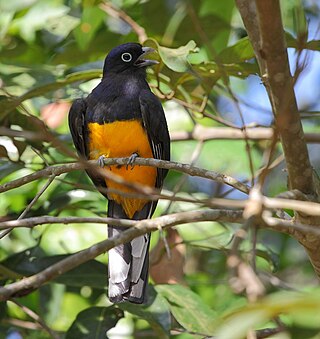
The green-backed trogon, also known as the Amazonian white-tailed trogon, is a bird in the trogon family Trogonidae. It is widely distributed across the Amazon rainforest with a disjunct population on the southeast coast of Brazil. As with all trogons, this species is sexually dimorphic. The male has a yellow belly without a white breastband, a blue head with a pale-blue orbital eye-ring, a blue bill, a green back and a green tail that is mostly white below. The female is duller with a dark grey head, a dark grey back and some black barring beneath the tail.























